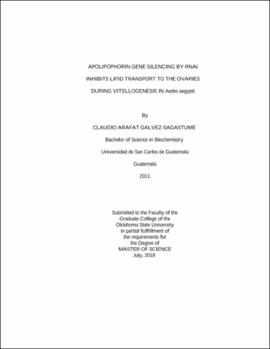| dc.contributor.advisor | Soulages, Jose | |
| dc.contributor.author | Galvez-Sagastume, Claudio Arafat | |
| dc.date.accessioned | 2019-03-25T20:05:28Z | |
| dc.date.available | 2019-03-25T20:05:28Z | |
| dc.date.issued | 2018-07 | |
| dc.identifier.uri | https://hdl.handle.net/11244/317711 | |
| dc.description.abstract | Aedes aegypti is an anautogenous species and serves as vector for several viruses that cause infection to hundreds of millions of people around the world, causing enormous economic burden. Lipids are essential for Aedes aegypti survival and reproduction. Their role during vitellogenesis is critical as primary energy source to support embryo and egg development. Considering the importance of lipids for this species and the epidemiological relevance of the diseases the species can carry and transmit to humans, this study was focused on lipid transport during vitellogenesis and the function of apolipophorin gene in this process. | |
| dc.description.abstract | This project was focused on studying lipid levels in fat body, hemolymph and ovaries during vitellogenesis. Lipophorin is the main lipid carrier for all insects. It is synthesized mainly in the fat body cells and secreted to the hemolymph to act as a shuttle loading and unloading lipids among tissues. Fat body synthesizes and accumulates lipids during the first 24 hours after a blood meal, then lipids are secreted to the hemolymph in the form of high density lipophorin and taken up by the ovaries for oocyte development, while lipid concentration in fat body returns to basal or below basal concentration. Lipid concentration in hemolymph increases gradually until 36 hours post blood meal, while ovaries accumulate lipids and reach a maximum concentration between 48 and 72 hours post blood meal, correlating with their size. | |
| dc.description.abstract | Using dsRNA as the inducer for RNA interference, apolipophorin gene was successfully silenced, causing lipid and protein accumulation in fat body, and lipid shortage in hemolymph and ovaries after blood feeding. Apolipophorin silencing also affected the size and shape of the ovaries, preventing their normal development. Other lipid transport related genes were also affected. Vitellogenin protein abundance in hemolymph and ovaries was increased, while mRNA did not show any significant change. Lipid transfer particle gene appeared to be downregulated at transcript level in fat body cells. | |
| dc.format | application/pdf | |
| dc.language | en_US | |
| dc.rights | Copyright is held by the author who has granted the Oklahoma State University Library the non-exclusive right to share this material in its institutional repository. Contact Digital Library Services at lib-dls@okstate.edu or 405-744-9161 for the permission policy on the use, reproduction or distribution of this material. | |
| dc.title | Apolipophorin gene silencing by RNAi inhibits lipid transport to the ovaries during vitellogenesis in Aedes aegypti | |
| dc.contributor.committeeMember | Arrese, Estela | |
| dc.contributor.committeeMember | Jiang, Haobo | |
| osu.filename | GalvezSagastume_okstate_0664M_15890.pdf | |
| osu.accesstype | Open Access | |
| dc.type.genre | Thesis | |
| dc.type.material | Text | |
| dc.subject.keywords | aedes | |
| dc.subject.keywords | aegypti | |
| dc.subject.keywords | apolipophorin | |
| dc.subject.keywords | rnai | |
| dc.subject.keywords | vitellogenesis | |
| thesis.degree.discipline | Biochemistry and Molecular Biology | |
| thesis.degree.grantor | Oklahoma State University | |
